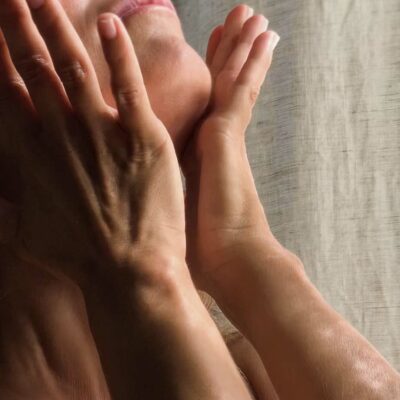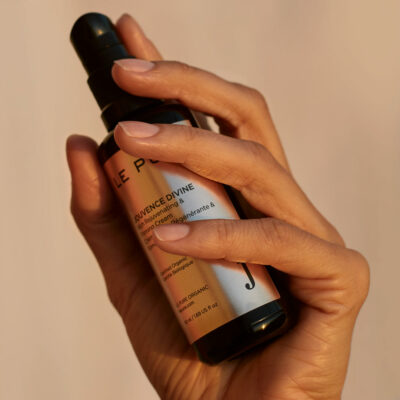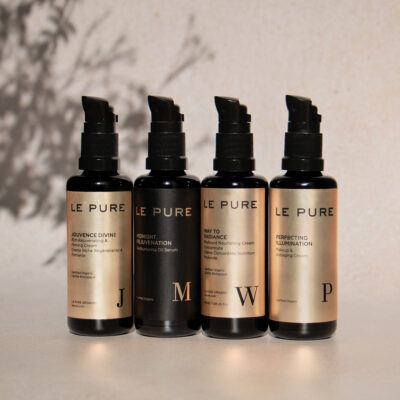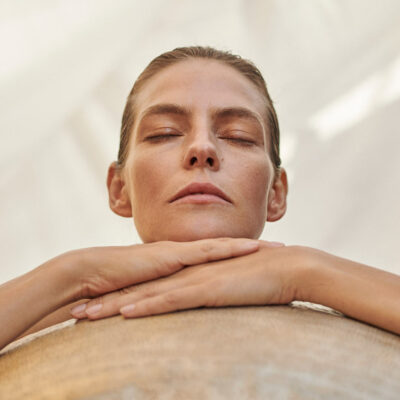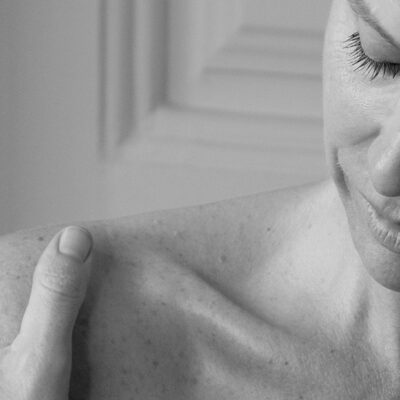Treatment for Acne
Skin with acne is characterized by redness and the presence of comedones, papules, and/or pustules. It is an inflammatory process, which develops in the hair follicles of the sebaceous glands. The treatment for acne includes a specific acne skincare routine, as well as the elimination of internal factors that can cause the appearance of acne or aggravate its symptoms.
Products for Acne
Acne Skincare Routine
The ideal acne skincare routine consists of an extremely gentle cleansing ritual to avoid the extension and aggravation of the inflammation. Touching the skin as little as possible is essential and the squeezing of pimples has to be avoided as it leads to scars and more pimples.
The Instant Liberation masque effectively purifies and treats the affected areas overnight and makes squeezing unnecessary.
Day Routine Acne
Cleanse the skin with Alpha Tonic. Apply Way to Radiance and massage it into the moist skin.
Night Routine Acne
Apply Alpha Tonic on a cotton pad moistened with water and gently cleanse with spiral movements following The Wave Cleansing Ritual. Spray Nectar Immortel onto the face and gently massage 1 dose of Midnight Rejuvenation into the damp skin.
Weekly Routine Acne
Every 10 days, after cleansing, apply the gentle exfoliation and natural retinol treatment True Revelation.
Five times per week, as the last step of the night routine and before going to bed, apply a thin layer of Instant Liberation like a cream and let it act overnight.
The different types of acne
There are many grades and types of acne. In case of moderate and severe acne the skin can present redness, papules and inflamed pimples. Acneic skin often forms on the face, on the neck, the breast, shoulders and back. If the face also presents a lot of redness, you should follow the treatment for rosacea with acne.
Oily skin is a common condition among teenagers, which is often accompanied by acne. At the end of the adolescence the hormonal levels stabilise and as a result the hyperactivity of the sebaceous glands ceases and the sebum production returns to normal.
People who suffered teenage acne may continue to have oily skin as adults and the symptoms that come with it (pimples and enlarged pores especially on the nose and chin). It is crucial to keep the skin perfectly purified, hydrated and nourished. Squeezing the pimples should be avoided at all costs as it can create scars and postinflammatory hyperpigmentation.
If acne appears after adolescence it is called adult acne. This is often the result of a lifestyle that promotes inflammation and the appearance of acne is one of the symptoms.
Nutrition, emotional stress and hormones are important factors that need to be taken into account when treating acne prone skin.
There are several different types of acne and how to classify them. But the most common types of acne are:
- Closed comedones (whiteheads): Closed comedones are very small white bumps that appear on the skin. They appear when oil and dead skin cells are clogged under the skin and block skin pores.
- Open comedones (blackheads): Open comedones are open to the surface and appear as dark small bumps on the skin. The excess of sebum oxidizes when it comes into contact with the air, hence the characteristic black color.
- Pustules (pimples): Pustules belong to the inflammatory acne types and are slightly larger bumps, usually accompanied by redness around the yellowish pus. The blocked pore is usually filled with immune cells and bacterial cells.
- Papules: Another mild type of acne are Papules. They appear as bumps on the skin with no clear centre, even though the skin around papules is usually red and inflamed.
- Cystic acne: Cystic acne is the most severe type of acne and appears as deep painful cysts under the skin’s surface. The pores are clogged with dead skin cells and oil. The very painful bumps appear red or white and usually are soft to the touch.
- Nodular acne: Nodules are a very severe type of acne. They arise when clogged skin pores get inflamed and result in hard, painful nodules without visible white- or blackheads. The nodules can last for weeks or months. Infection and inflammation occur due to the entrapment of the bacteria Cutibacterium under the skin.
What causes acne?
It is crucial to determine the underlying factors of what causes acne. Very often there is one primary cause of acne, which is aggravated by a series of other internal and external factors. To treat acne successfully, we have to address all potential causes and optimize our lifestyle and habits.
- Nutrition and Acne
- Emotional stress and Acne
- Hormones and Acne
- Vitamin D and Acne
- Digestive problems and Acne
- Diseases Causing Acne
- Acne Caused by Medication
- Skincare Rituals Aggravating Acne
- Skincare products Causing Acne
- Acne caused by Sun exposure
- Teeth and Acne
1. Nutrition and Acne
The relationship between nutrition and acne should be one of the first revisions when creating an integrative acne treatment plan. An excess of carbohydrates, while consuming too few high-quality proteins and fats can lead to a nutritional as well as hormonal imbalance that favors the appearance of acne. Avoid sugar and sugar substitutes such as honey and natural syrups, as well as juices and smoothies. Opt for a savory breakfast and reduce the amount of starches, carbohydrates, and dairy in your diet. Dairy products have an inflammatory effect on the body and should be consumed in small amounts, preferably organic and from goat and sheep.
Nutrition in adolescence has an important role in how the skin and the sebum evolve. A high consumption of sugar and foods rich in sugar leads to an increased risk of developing teenage acne. Sugar has a component that is directly linked to fat. An optimal diet is the basis of a balanced hormonal system and therefore also a balanced skin. Bad nutrition over the course of many years combined with phases of emotional stress can favor the appearance of acne. Diet and skin have long-term effects. Skin alterations are not created in one day, but are the sum of our lifestyle during months or years.
2. Emotional Stress and Acne
Emotions are an important part of our health from the very beginning. Depending on the stress factors around us, we can experience already very strong, defining emotions as infants. If we do not resolve such negative experiences and learn how to deal with emotional problems, these early emotional stress moments can define us during our entire life. In some people a combination of emotional stress with different factors such as unbalanced nutrition can cause skin alterations.
There is also positive stress, called eustress, that is related to a beneficial short term activation focused on a certain attainable objective or project. It is related to balance, enthusiasm and passion.
But there is also toxic stress that leads to negative thoughts and patterns. Behind this type of stress is a lack of self esteem that leads to constant self criticism and judgement. Our skin reflects how we “face” the circumstances and difficulties of life.
Toxic stress creates a constant imbalance in our body and can affect our health. Often acne prone skin is related to patterns of self-criticism and fears that affect our body as well as our skin. The skin of the face is a very visible part of us; therefore acne and inflammation communicate our unresolved emotions to the outside world.
3. Hormones and Acne
The top of the pyramid of nutrition and emotional stress is the hormonal system. The connection between hormones and acne has to be closely examined to determine if a hormonal imbalance is causing or aggravating the appearance of acne.
The foods and the emotions that nourish us have a great impact on the balance of our hormones. An imbalance of the hormones can lead to inflammation and the overproduction of sebum in our skin, causing acneic skin.
4. Vitamin D and Acne
A deficiency of Vitamin D and acne are often closely linked. Low vitamin D values affect our body on many different levels and are linked to inflammation. Vitamin D deficiency can affect the correct functioning of the thyroid gland, which regulates our hormonal system. Unbalanced hormones can cause inflammation and affect the skin sebum. It is essential to determine the vitamin D levels with a blood test and in case of deficiency get the correct prescription by a medical professional.
5. Digestive Problems and Acne
The combination of digestive problems and acne is often no coincidence. Leaky gut, also called increased intestinal permeability, is a source of inflammation within the body which can also increase the permeability of the skin. Together with other factors, digestive problems can favor or aggravate skin with acneic tendencies.
6. Diseases Causing Acne
Some autoimmune diseases are causing acne. Your doctor should advise you if there is an association between your disease and acne. While certain symptoms or medication side effects may not be eliminated, you can optimize your nutrition, emotional well-being, and skincare ritual to mitigate the effects of acne caused by disease.
An overloaded liver can lead to the appearance of acne. Hormones, alcohol, caffeine, or inflammatory bi-products from food can burden the liver, resulting in the formation of acne due to this overload.
7. Acne Caused by Medication
In some cases, acne is caused by medication. While some women are prescribed contraceptives to treat acne, this is often only a temporary solution. Once you stop taking the contraceptive pill, in many cases there is a surge of acne as the body is trying to balance its hormones. In that case, you need to be patient and wait until the hormonal system and the skin recuperate its natural balance. It can take many months until the natural balance is restored. In the meantime, focus on anti-inflammatory nutrition, emotional balance, and the ideal acne skincare routine.
8. Skincare Rituals Aggravating Acne
An important and often overlooked factor is that harsh skincare rituals can aggravate acne. In case of inflammation of the skin, it is essential to avoid any kind of rubbing or harsh movements when cleansing the skin.
Make gentle movements as explained in the Wave Cleansing Ritual or in severe cases just pad the skin with the cotton pad. Touching your skin in an extremely gentle manner is essential to avoid the extension of the inflammation.
Never touch the pimples and comedones as this can lead to scars and postinflammatory hyperpigmentation. Spray Nectar Immortel on the skin throughout the day and apply Instant Liberation on the affected areas at night.
9. Skin Products Causing Acne
It is possible that certain skin products cause acne. Cosmetics that contain synthetic fats (e.g. petroleum derivatives or silicones) or chemically modified fats (e.g. Cetearyl Alcohol, Caprylic/Capric Triglyceride, Stearate) can obstruct the pores, causing or aggravating acneic skin.
On the other hand, there are many products that have a drying effect on the skin such as cleansing gels and acids. However, the constant drying up of the skin can lead to increased sebum production as the skin notices that it lacks skin fat and starts to produce more.
Cosmetic substances such as preservatives (parabens, etc.) and chemical sunscreen filters can disrupt the hormonal balance of the body, leading to an imbalance in sebum production.
10. Acne Caused by Sun Exposure
We recommend avoiding excessive sun exposure as the sun does not cure acne. On the contrary, it is a false friend of skin with acne. At first, it seems that the drying effect of the sun improves acneic skin, but the ultraviolet B rays increase the thickness of the epidermis, causing microcysts and blackheads. Due to this effect, acne is caused by sun exposure and starts to appear or worsen at the end of the summer or after vacations in the sun.
11. Teeth and Acne
Teeth problems and acne are often closely related. Any kind of infection or inflammation in the mouth has a negative effect on the skin of the face. Inflamed root canals are sometimes the cause of persistent cases of acne. Inflammation and cysts are often not visible on normal X-rays and require a CT or cone-beam scan. Find a biological dentist, who can help you assess the health of your teeth and gums.









